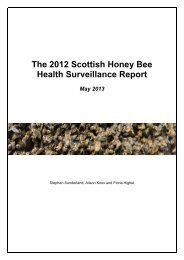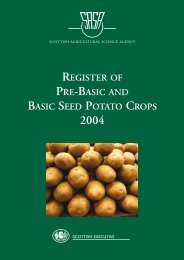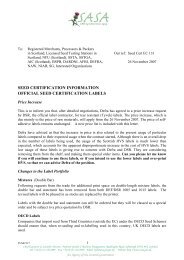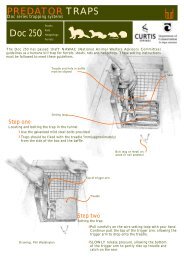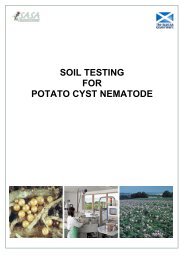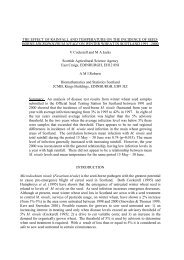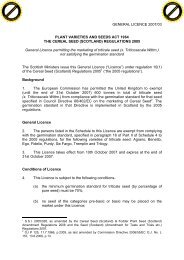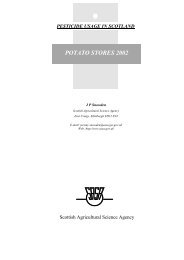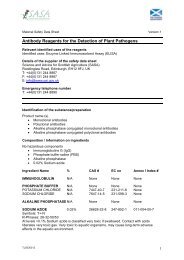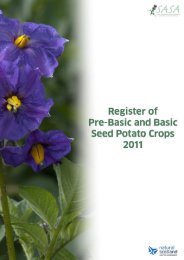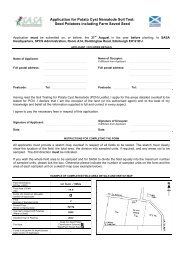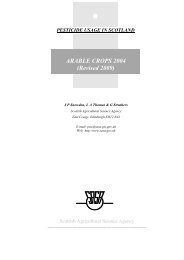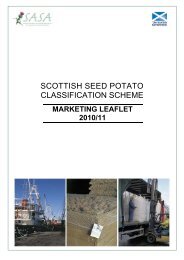You also want an ePaper? Increase the reach of your titles
YUMPU automatically turns print PDFs into web optimized ePapers that Google loves.
<strong>Crop</strong> <strong>Production</strong> <strong>in</strong> <strong>the</strong> <strong>East</strong> <strong>of</strong> <strong>Scotland</strong>history. As this history is dist<strong>in</strong>ctlydifferent from that <strong>of</strong> o<strong>the</strong>r Europeancountries, a brief guide follows.Orig<strong>in</strong>s<strong>Scotland</strong> was entirely encased <strong>in</strong> ice up to20,000 years ago, and <strong>the</strong> land surface wasnot f<strong>in</strong>ally exposed for a fur<strong>the</strong>r 10,000years. Some important arable areas, forexample <strong>the</strong> Laich <strong>of</strong> Moray and <strong>the</strong>carselands <strong>of</strong> Perth and Stirl<strong>in</strong>g, did notfully emerge from <strong>the</strong> sea until around1,000 years ago, as a result <strong>of</strong> <strong>the</strong> slowrebound <strong>of</strong> surfaces depressed by hugeweights <strong>of</strong> ice. As no soils from previous<strong>in</strong>terglacial periods survive, virtually all <strong>of</strong><strong>the</strong> soils <strong>of</strong> <strong>Scotland</strong> date from around10,000 years ago (Chapter 3).As <strong>the</strong> climate improved, <strong>the</strong> advance <strong>of</strong>vegetation culm<strong>in</strong>ated <strong>in</strong> dense forest andscrub (vary<strong>in</strong>g proportions <strong>of</strong> birch, p<strong>in</strong>e,hazel and oak, depend<strong>in</strong>g on habitat, withalder and willows <strong>in</strong> wet areas). The earlyhunters would have had little impact on <strong>the</strong>environment but, by <strong>the</strong> start <strong>of</strong> <strong>the</strong>Second Millennium BC, a surpris<strong>in</strong>glysophisticated neolithic society (f<strong>in</strong>e goldjewellery, elaborate pottery and complexfunerary arrangements) had emerged <strong>in</strong> <strong>the</strong>lowlands <strong>of</strong> <strong>Scotland</strong>; <strong>the</strong>se people were atleast partly sedentary and partly dependentupon small-scale cropp<strong>in</strong>g <strong>of</strong> cereals andfibres, and livestock rear<strong>in</strong>g. They wereattracted by light, well-dra<strong>in</strong>ed soils,particularly <strong>in</strong> treeless areas such asOrkney but, on <strong>the</strong> ma<strong>in</strong>land, <strong>the</strong>y began<strong>the</strong> onerous work <strong>of</strong> fell<strong>in</strong>g <strong>the</strong> forest andclear<strong>in</strong>g stones and boulders. Laterneolithic/Bronze Age achievements, notablymegalithic build<strong>in</strong>g (e.g. Maes Howe) andcomplex stone circles (e.g. at Callanish),show that <strong>the</strong>re was a cont<strong>in</strong>u<strong>in</strong>g surplus <strong>of</strong>food beyond subsistence needs.Up to <strong>the</strong> medieval period, <strong>the</strong> rate <strong>of</strong>progress <strong>in</strong> clear<strong>in</strong>g <strong>the</strong> forest andcultivat<strong>in</strong>g <strong>the</strong> soil <strong>of</strong> <strong>the</strong> lowlandsdepended upon a variety <strong>of</strong> factors (e.g.slowed by cooler, wetter conditions around1,000BC; accelerated by <strong>the</strong> advent <strong>of</strong> irontools around 500BC; <strong>in</strong>terrupted by periods<strong>of</strong> warfare). By 1200AD, it is likely thatmost <strong>of</strong> <strong>the</strong> potentially-productive lowlands<strong>of</strong> <strong>the</strong> <strong>East</strong> <strong>of</strong> <strong>Scotland</strong> had been cleared <strong>of</strong>forest. The uplands also began to lose <strong>the</strong>irforest cover at that time ow<strong>in</strong>g to <strong>the</strong><strong>in</strong>tensive sheep rear<strong>in</strong>g <strong>in</strong>troduced by <strong>the</strong>monasteries; graz<strong>in</strong>g pressure and timberexploitation over <strong>the</strong> follow<strong>in</strong>g 500 yearsensured that virtually all <strong>of</strong> <strong>the</strong> nativewoodland <strong>in</strong> <strong>the</strong> study area disappeared.The areas <strong>of</strong> arable agriculture (more<strong>in</strong>tensively-cultivated <strong>in</strong>field, and outfield,with complex subdivisions to ensure fairdistribution <strong>of</strong> land among tenants),devoted to <strong>the</strong> production <strong>of</strong> barley andoats for direct human consumption, wereislands <strong>of</strong> cultivation <strong>in</strong> a wider sea <strong>of</strong>common land, which was exploited forgraz<strong>in</strong>g, fuel (wood and peat) and build<strong>in</strong>gmaterials (stone and turf). The fraction <strong>of</strong><strong>the</strong> land area that was cultivated fluctuatedaccord<strong>in</strong>g to population and climaticchanges, but, at least from <strong>the</strong> seventeenthcentury onwards, an <strong>in</strong>creas<strong>in</strong>g proportion<strong>of</strong> <strong>the</strong> uncultivated land came <strong>in</strong>tocultivation.The Basis <strong>of</strong> Land TenureFrom around 1150, <strong>the</strong> rulers <strong>of</strong> <strong>Scotland</strong><strong>in</strong>troduced a feudal system <strong>of</strong> land tenureto <strong>the</strong> lowlands <strong>of</strong> <strong>Scotland</strong>, although moredist<strong>in</strong>ctly Celtic or Nordic arrangements didsurvive much longer <strong>in</strong> <strong>the</strong> West and North.In <strong>the</strong> <strong>East</strong> <strong>of</strong> <strong>Scotland</strong>, as def<strong>in</strong>ed here, <strong>the</strong>changes were complete by 1250, after <strong>the</strong>military subjugation <strong>of</strong> <strong>the</strong> last Celtic rulers<strong>of</strong> Moray. Although formally styled K<strong>in</strong>g orQueen <strong>of</strong> Scots, <strong>the</strong> medieval rulers <strong>of</strong><strong>Scotland</strong> considered <strong>the</strong>mselves to beoutright owners <strong>of</strong> all <strong>of</strong> its land. Theconcept <strong>of</strong> feudal tenure was imposed onEngland by <strong>the</strong> <strong>in</strong>vad<strong>in</strong>g Normans (i.e. from10



